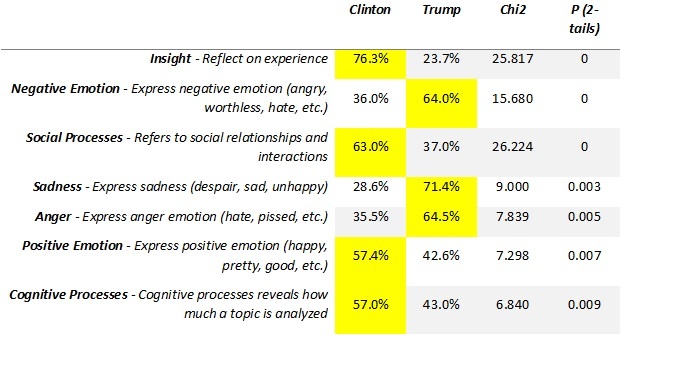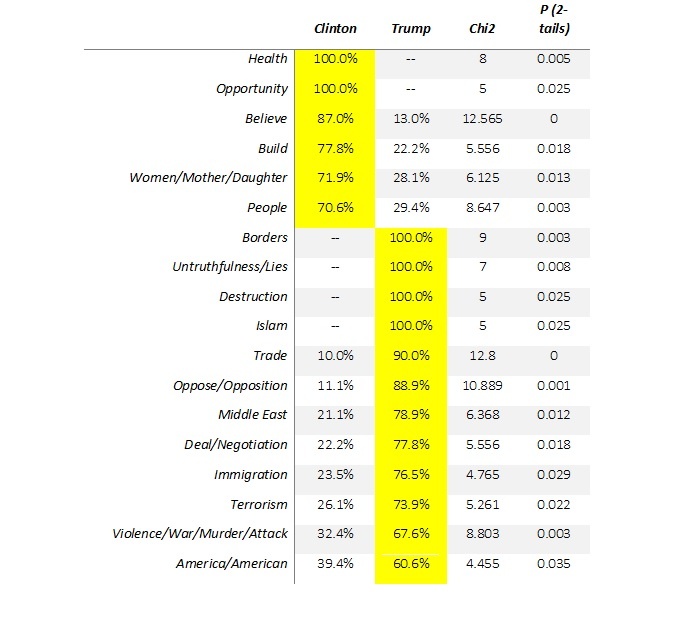 The media has covered voter perceptions of Hillary Clinton and Donald Trump’s presidential acceptance speeches to great length. Some have suggested that voters perceive the overall tone of the RNC, and specifically Trump’s acceptance speech, to be one of doom and gloom, and the tone of the DNC and Clinton’s speech to be one of hope and forward movement.
The media has covered voter perceptions of Hillary Clinton and Donald Trump’s presidential acceptance speeches to great length. Some have suggested that voters perceive the overall tone of the RNC, and specifically Trump’s acceptance speech, to be one of doom and gloom, and the tone of the DNC and Clinton’s speech to be one of hope and forward movement.
But is that true? To understand the nomination speeches, Beall Research analyzed them using a proprietary digital listening tool. We typically use this tool to reveal emotions, psychological processes, and cognitive processes for consumer brands, products, and services. We were curious what our tool would reveal about Trump and Clinton’s acceptance speeches.
Methodology
We analyzed Donald Trump’s speech at the Republican Convention on Thursday, July 21, 2016 and Hillary Clinton’s speech at the Democratic Convention on Thursday, July 28, 2016. Trump’s speech totaled 4,382 words and Clinton’s speech totaled 5,191 words. Each speech was weighted so it would have the same number of words: 5,000.
Two types of text analysis were conducted:
- The first, a proprietary linguistics analysis, is a standard analysis conducted at Beall Research and is typically used to understand consumers’ perceptions and sentiments towards brands, products, and services.
- The second type of analysis is customized for each project. This analysis measures a range of topics, including: brand/product attributes, source of awareness, usage frequency or occasion, purchase channel, satisfaction, brand evangelization, purchase barriers, etc.
Notes on Interpreting Data
In the analysis, rows present each candidate’s share of a particular category, which adds up to 100%. In other words, each item occurred a certain percentage of the time in Trump’s speech and in Clinton’s speech.
A Chi Square score is calculated for each distribution, measuring how much a particular distribution varies from what we would expect to occur by chance. We would normally expect that each item would occur equally in both speeches. If the item occurred more than would be expected by chance, the chi-square statistic will be statistically significant with a P-value below .05.
Linguistics Text Analysis Findings
In this linguistics analysis, we found that Trump’s speech had more negative emotions such as anger (i.e., “fight,” “hatred,” “threaten,” “destruction”) and sadness (i.e., “suffering,” “helpless,” “regrets”) than did Clinton’s speech. Across both speeches, nearly two-in-three expressions of negative emotion are from Trump.
- “This is the legacy of Hillary Clinton: death, destruction and weakness.” – Donald Trump
- “Not only have our citizens endured domestic disaster, but they have lived through one international humiliation after another.” – Donald Trump
In contrast, Clinton’s speech is distinguished from Trump’s speech in that there are significantly more words with positive emotion, such as “courage,” “talent,” “love,” and “share.” Additionally, Clinton’s speech contains more words that demonstrate some level of cognitive analysis of and engagement with the subject matter; for example: “question,” “believe,” “sense,” “solution,” “imagine,” “decisions,” “ideas,” and “effects.”
- “You want a leader who understands we are stronger when we work with our allies around the world and care for our veterans here at home.” – Hillary Clinton
- “I believe in science. I believe that climate change is real and that we can save our planet while creating millions of good-paying clean energy jobs.” – Hillary Clinton

Custom Analysis
We also conducted an analysis of the specific issues that both candidates discussed. In this analysis, we found that Clinton’s speech discussed salient issues such as “health,” references to “women/daughters/mothers,” and ideals and values (i.e., using words such as “build,” “strong,” “belong,” “opportunity”).
Trump’s speech covered matters that are neutral to negative in sentiment, and words such as “oppose/opposition,” “borders,” and "violence/war/murder/attack" are found at significantly higher rates. He also mentions “lying,” “laws,” and “deals” more than Clinton. Trump’s speech also contained more polarizing public policy references (“terrorism,” “refugees,” “trade”) or failings and defects (“untruthfulness,” “destruction”).
Interestingly, when the two candidates are talking about the general public, Clinton is more likely to use the generic term “people” and Trump is more likely to use a more patriotic word, “Americans.”

Final Takeaways
Linguistics analysis supports voter perceptions that Trump’s speech contained significantly more negative content and emotion than Clinton’s speech. Interestingly, Clinton uses significantly more words and phrases that communicate psychological processes such as insight (reflect on experience) and cognitive processes (express that a topic has been analyzed), which may contribute to positive perceptions by signaling to voters that her ideas are formed through thought and reflection.
To keep up with new ideas and best practices, subscribe to the MarketResearch.com blog.
 About the Author: Gina Zuercher is an Associate Group Director at Beall Research, Inc., where she oversees both quantitative and qualitative market research studies. Gina has over a decade’s experience in generating consumer insights across a variety of industries, including CPG, consumer durables, retail and grocery. She received her B.A. from Marquette.
About the Author: Gina Zuercher is an Associate Group Director at Beall Research, Inc., where she oversees both quantitative and qualitative market research studies. Gina has over a decade’s experience in generating consumer insights across a variety of industries, including CPG, consumer durables, retail and grocery. She received her B.A. from Marquette.
Beall Research is a strategic market research firm located in Chicago that specializes in qualitative and quantitative research. Beall Research has years of experience applying linguistics and custom text analysis to brands, products, and services. Text analysis is practical because it is a cost- and time-efficient method to measure consumer perceptions contained within unstructured data already available online (i.e., consumer reviews, blogs, social media).


